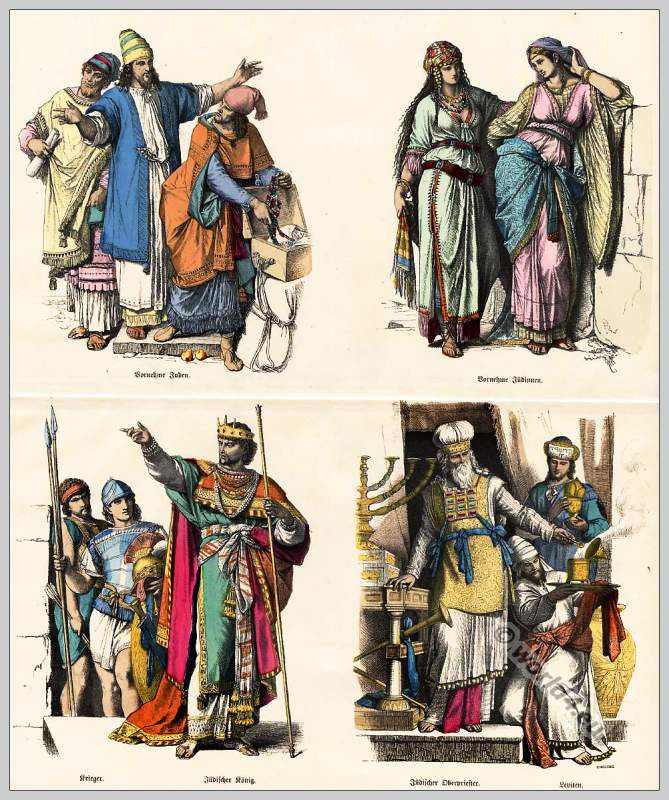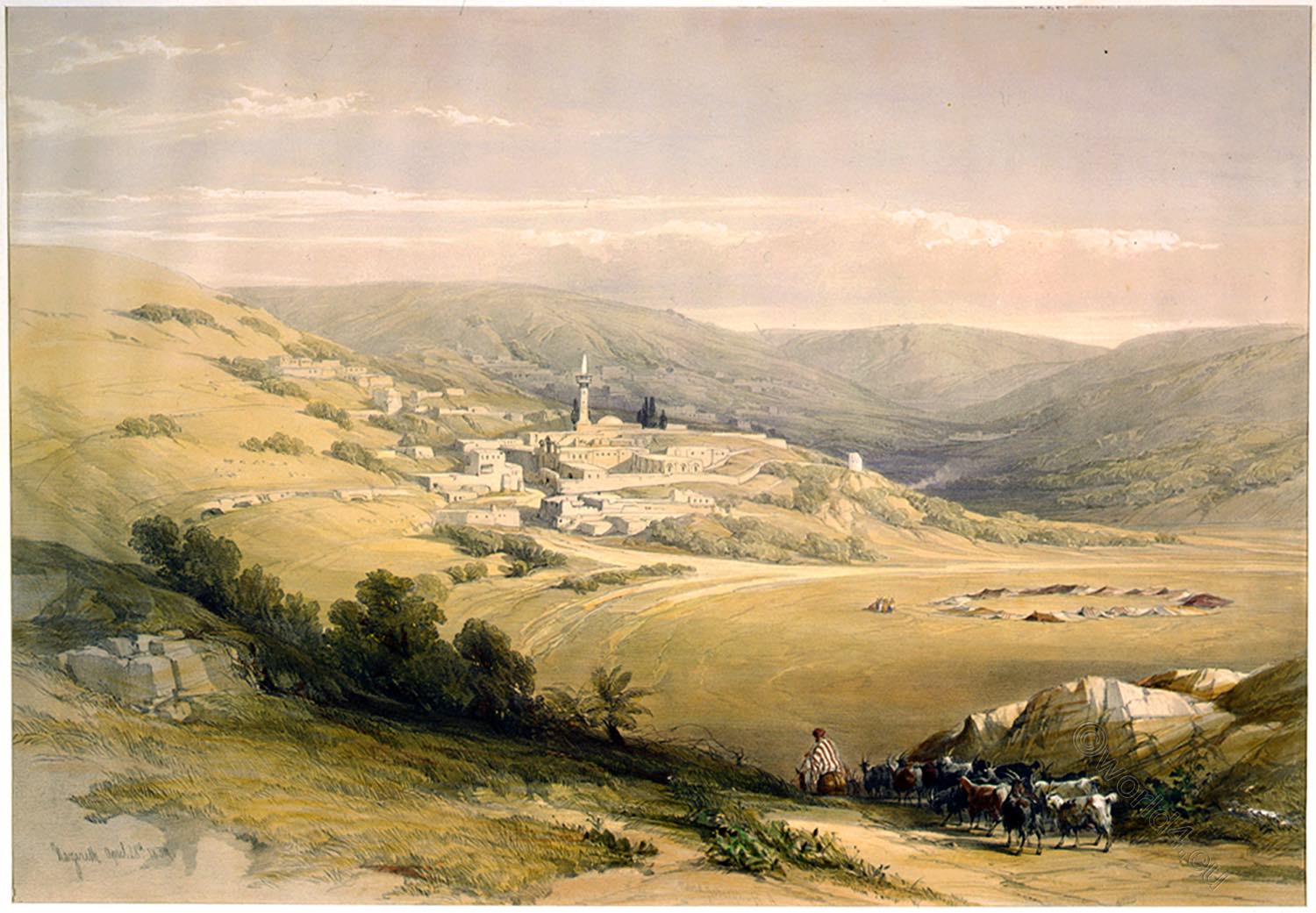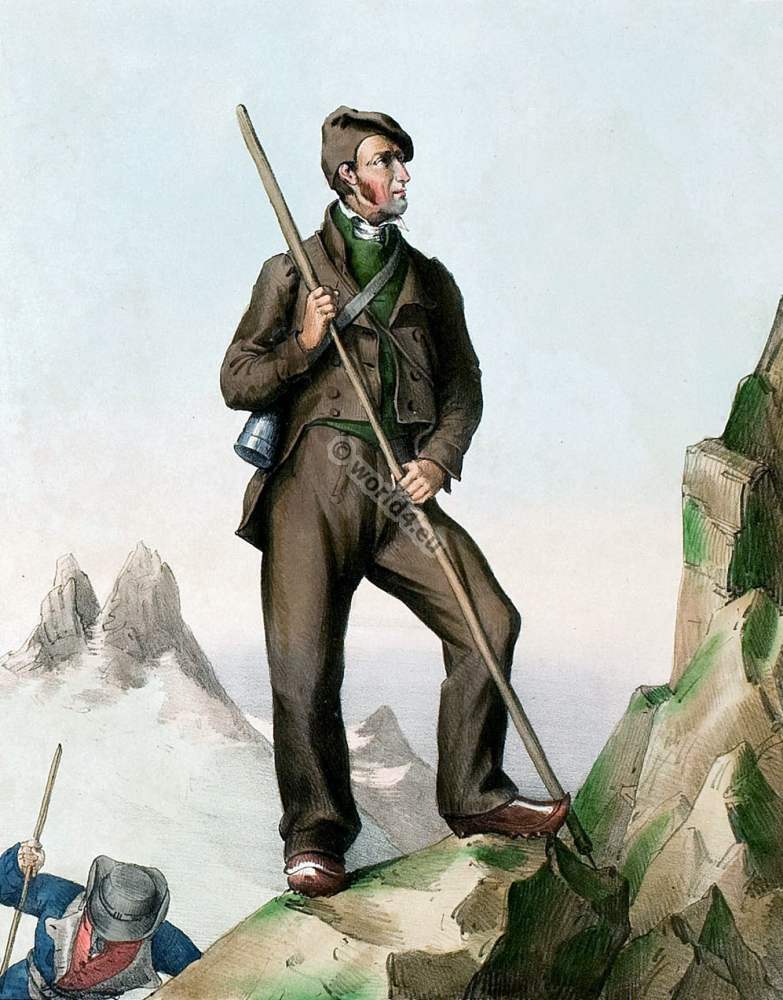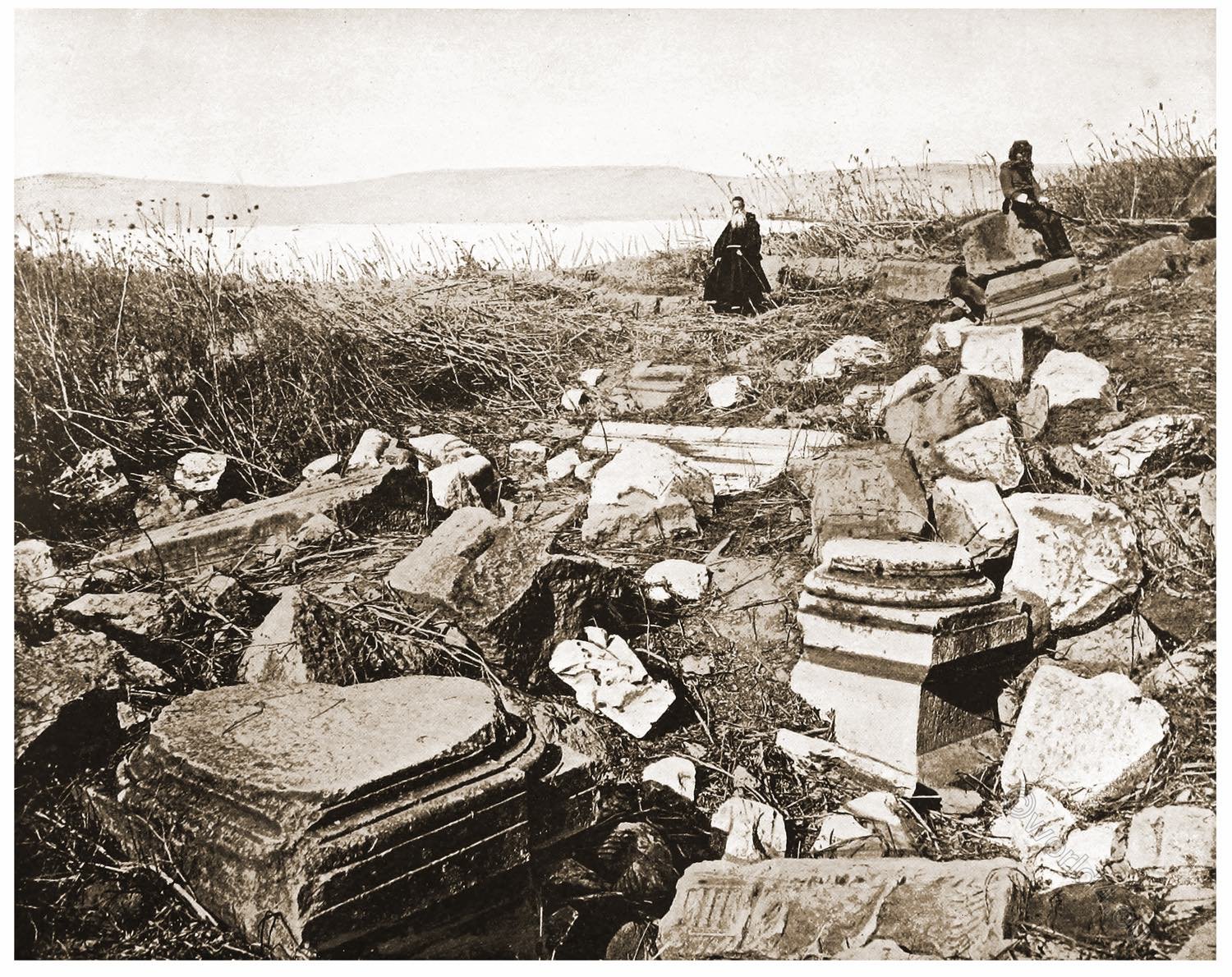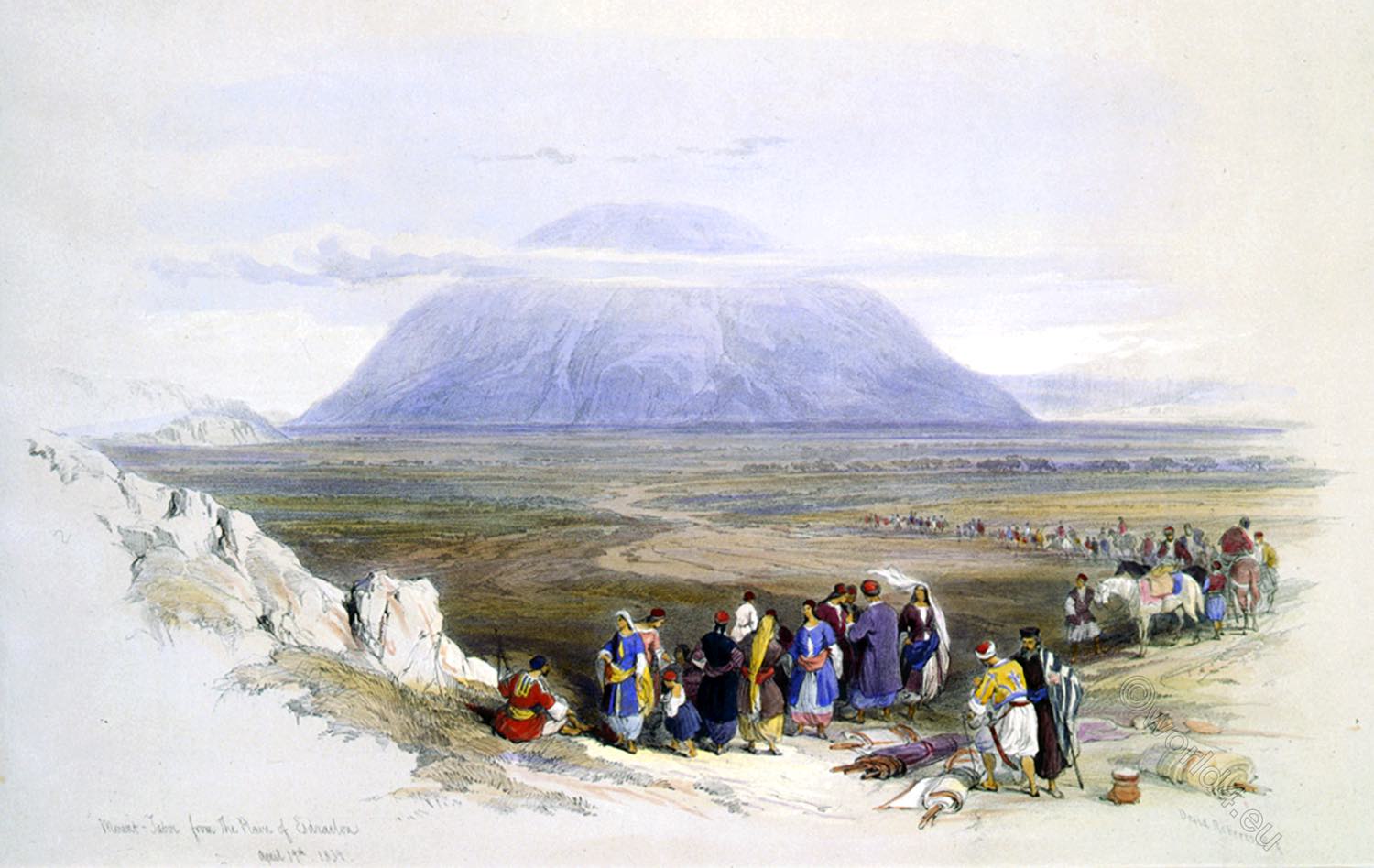
Mount Tabor (Hebrew הר תבור, Har Tavor, Latin: Atabyrion) is a mountain on the eastern edge of the Jezreel Plain in Galilee in northern Israel. In biblical tradition, Mount Tabor is the mountain of the world: Hebrew tabbur means “navel (of the world)”. Christians associate the transfiguration of the Lord with it. Jesus appeared to his disciples in divine form on the “Transfiguration Mountain” (Matthew 17, Mark 9, Luke 9). The light they saw is called Tabor light; it played a major role in the debates about Hesychasm *) in the 14th century.
It was once a famous pre-Christian place of worship in antiquity and, according to Christian tradition, is said to have been the site of the Transfiguration of Jesus Christ. Its isolated location and its height of 588 metres are very striking; the peak is several hundred metres above the surrounding landscape and is still a destination for Roman Catholic and Greek Orthodox pilgrims as well as tourists.
MOUNT TABOR, FROM THE PLAIN OF ESDRAELON
by David Roberts.
Tabor is a beautiful mountain, wholly of limestone, and rising about a thousand feet above the great Plain of Esdraelon. Among the Arabs it bears only the general name of Jebel-el-Tur.
It stands out alone towards the S.E. from the high land around Nazareth, while the north-eastern arm of the Plain sweeps round its base, and extending far to the North, forms a broad table-land, bordering on the Valley of the Jordan and the Lake of Tiberias.
Seen from the S.W. it has the appearance of the segment of a sphere, but from the W.N.W. that of a truncated cone. The summit is a little oblong plain or basin. 1)
“The present view,” observes the Artist, “was taken while crossing the Plain, on the road from Jenin to Nazareth. It is the very opposite to the ruggedness and grandeur given to its form in the sketches which I had hitherto seen.
Though a fine hill, it has long lost all claims to the picturesque; the labors of the ancient population having cleared and shaped it into its present form.
In many instances this process may be still traced by the terraces remaining on the sides, though often, by time, undistinguishable in color from the rocks on which they are raised. The general character of the hills of Palestine is round- ness, arising from the same cause.” 2)
The figures in the foreground are a caravan of Christian pilgrims, whom the Artist found resting during the mid-day, on their return from Damascus to Jerusalem.
1) Biblical Researches, iii. 211, &c. 2) Roberts’s Journal.

*) The medieval hesychastic movement had its centre in the monasteries and skites on Mount Athos. In its heyday in the late Middle Ages, it also spread to the northern Balkans and Russia.
Hesychasm (ancient Greek ἡσυχασμός hēsychasmós) is a form of spirituality developed in the Middle Ages by orthodox Byzantine monks. Its starting point is formed by rules of conduct of late antique monasticism. The term is derived from the Greek word hesychia (ἡσυχία hēsychía), which means “calm” or “silence”. Associated with hesychia are the ideas of serenity and inner peace. Hesychasts make the attainment and preservation of such calm the goal of intensive systematic efforts.
The realisation of hesychia is achieved through persistent practice within the framework of a special prayer practice. The praying hesychasts repeat the Jesus Prayer over long periods of time. They use a breathing technique as an aid to concentration. The aim is to achieve a state of complete peace of mind, which is considered a prerequisite for experiencing a special divine grace: according to the Hesychasts, those who pray can perceive the uncreated Tabor light in a vision.
The doctrine that God himself is present and visible in the uncreated light has been part of the core of hesychastic beliefs since the late Middle Ages.
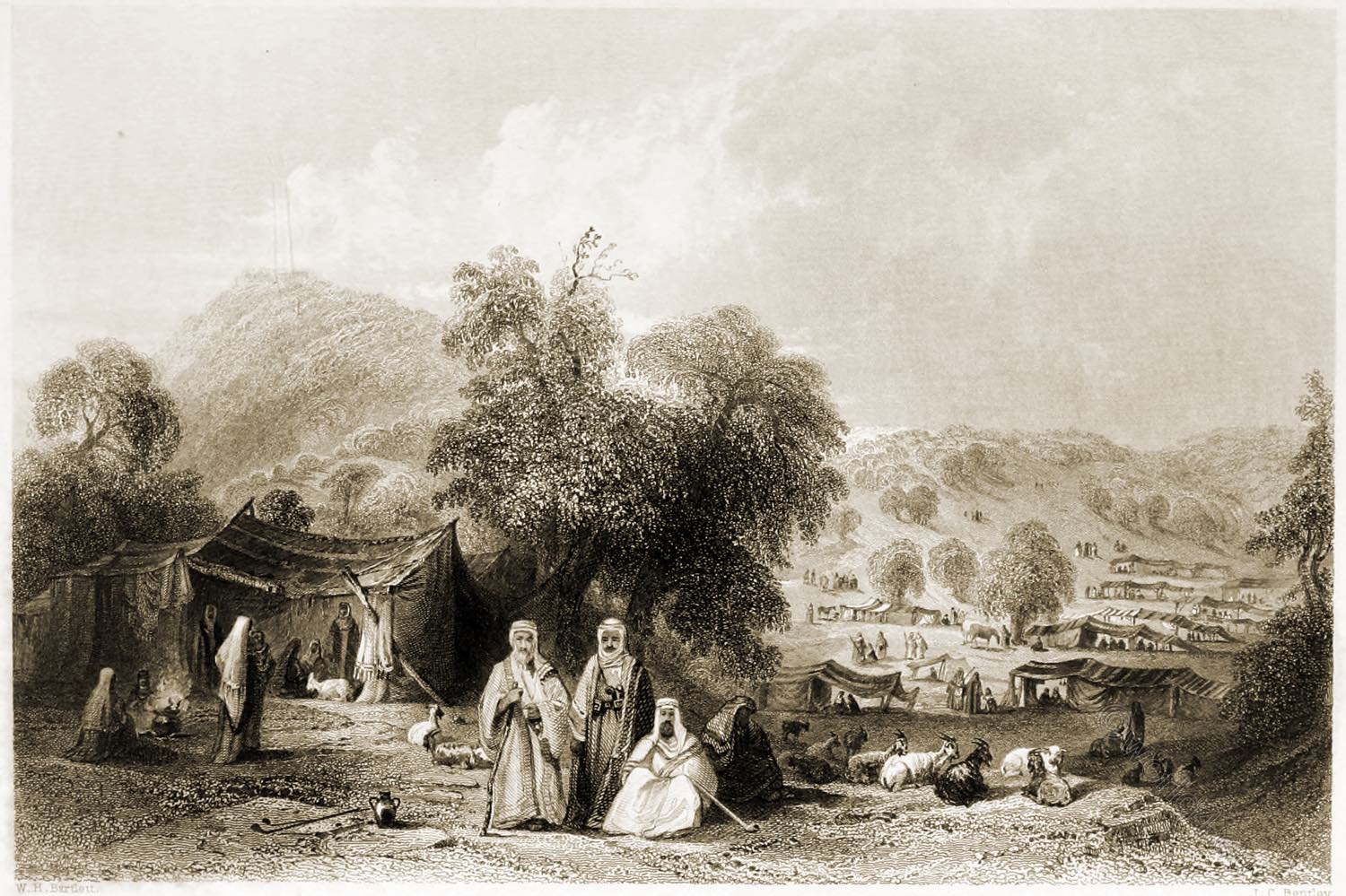

MOUNT TABOR.
Drawn by J. D. Harding, from a Sketch made on the spot by the Hon. Capt. Fitzmaurice.
Mount Tabor, or Thabor, as it is sometimes called, is a calcareous mountain of a conical form, entirely detached from any neighboring mountain: it stands on one side of the great plain of Esdraelon. The sides are rugged and precipitous, and covered to the summit with the most beautiful shrubs and flowers.
Here Barak was encamped when, at the suggestion of the prophetess Deborah, he descended with ten thousand men, and discomfited the host of Sisera. (Judg. iv. 6, &c.) And, long afterwards, Hosea reproached the princes of Israel and the priests of the golden calves with having “been a snare in Mizpeh and a net spread upon Tabor” (Hos. v. 1.), doubtless referring to the altars and idols which were here set up; and on this “high mountain apart” the transfiguration of Jesus Christ is generally believed to have taken place. (Matt. xvii. 1, 2.) Tabor is computed to be about a mile in height.
To a person standing at its foot, it appears to terminate in a point: but, on reaching the top, he is agreeably surprised to find an oval plain, about a quarter of a mile in its greatest length, covered with a bed of fertile soil on the west, and having on its eastern side a mass of ruins, apparently the vestiges of churches, grottoes, and strong walls, all decidedly of some antiquity, and a few appearing to be the works of a very remote age.
The Hon. Capt. Fitzmaurice, who visited this mountain in February,
1833, states that he saw the ruins of a very ancient church, built over the spot where the transfiguration is supposed to have taken place.
The prospects from the summit of Mount Tabor are singularly delightful and extensive. On the north-west, says Mr. Buckingham, (whose graphic description has been confirmed by subsequent travelers), we had a view of the Mediterranean Sea, whose blue surface filled up an open space left by a downward bend in the outline of the western hills: to the west-north-west a small portion of its waters were seen; and on the west, again, the slender line of the distant horizon was just perceptible over the range of land near the sea-coast.
From the west to the south, the plain of Esdraelon extended over a vast space, being bounded on the south by a range of hills generally considered to be Hermon, whose dews are poetically celebrated (Psal. cxxxiii. 3.), and having in the same direction, nearer the foot of Tabor, the springs of Ain-el-Sherar, which send a perceptible stream through its centre, and form the brook Kishon of antiquity.
From the south-east to the east is the plain of Galilee, being almost a continuation of Esdraelon, and, like it, appearing to be highly cultivated. Beneath the range of Hermon is seated Endor, famed for the witch who raised the ghost of Samuel (1 Sam. xxviii.), and Nam, equally celebrated as the place at which Jesus raised to life the only son of a widow, and restored him to his afflicted parent.
The range which bounds the eastern view is thought to be the ‘mountains of Gilboa,’ so fatal to Saul. (1 Sam. xxxi.) The Sea of Tiberias, also Sea of Galilee or Lake of Gennesaret, is clearly discovered towards the north-east, and somewhat farther in this direction is pointed out the village of Saphet, anciently named Bethulia, the city alluded to by Jesus Christ in his divine sermon on the Mount, from which it is also very conspicuous.
“The rest of this glorious panorama comprehends the sublime ‘Mount of Beatitudes,’ upon which that memorable sermon was delivered, together with the route to Damascus, and, lastly, Mount Lebanon, towering in the background in prodigious grandeur, the summit of which is covered with perpetual snow.”
Jolliffe’s Letters from Palestine, p. 140. Buckingham’s Travels in Palestine, pp. 107—109. Dr. E. D. Clarke’s Travels in Greece, &c. vol. iv. p. 238. Rae Wilson’s Travels, vol. ii. pp. 32—35. The Hon. Capt. Fitzmaurice’s (unpublished) Cruise to Egypt, Palestine, and Greece, p. 58.
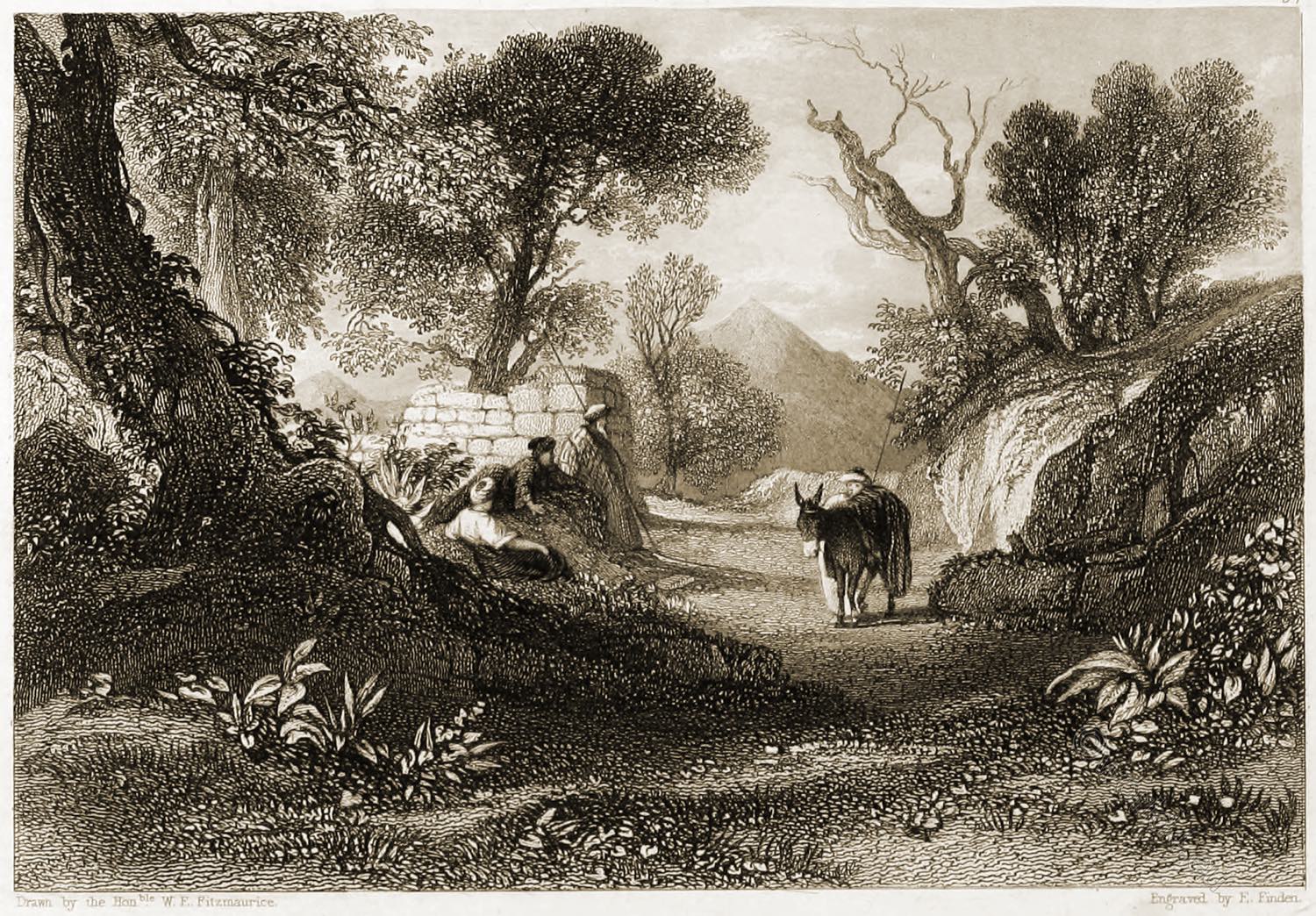
THE SUMMIT OF MOUNT TABOR.
Drawn by the Hon. Capt. W. E. Fitzmaurice.
Mount Tabor, by the Arabs called Djebel Tour, is situated in the middle of Galilee, on the confines of the allotment of the tribes of Issachar and Naphtali: it is comprehended in the portion assigned to the children of Issachar, as their inheritance in the land of Canaan (Josh. xix. 17 — 23.), and is one of those elevations where Jesus Christ was accustomed to retire for meditation and prayer.
In the Old Testament it is classed with Mount Hermon (Psalm lxxxix. 12.), which is distinctly seen from it. Referring the reader to Part X., in which another view and description of this mountain are given, together with the diversified and extensive scenery which it commands, we now invite his attention to a few particulars more immediately connected with its summit.
This conical mountain is computed to be about a mile in height, and its summit is flat and very fertile, being thickly studded with trees and shrubs; though towards the south it is more open; and from that quarter there is a most delightful view, which abundantly compensates for the exertion attending the difficult ascent up its rugged and precipitous sides.
Anciently, it would seem that a city was built upon this summit, and assigned with its suburbs to the children of Merari. (1 Chron. vi. 77.) To the west are scattered fragments of walls and other ruins. The empress Helena founded here two monasteries, one in memory of Moses, and the other of Elias. The Hon. Capt. Fitzmaurice saw here, in February, 1833, the ruins of a very ancient church, built over the spot where the Transfiguration is supposed to have taken place.
Three grottos or excavations in the rock, by the neighboring monks called “Tria Tabernacula,” were pointed out to Mr. Rae Wilson, as having been made to commemorate that event; the remembrance of which is perpetuated by an annual procession to a rude altar, at which various acts of devotion are performed.
Hon. Capt. Fitzmaurice’s (unpublished) Cruise to Egypt, &c. p. 56. Rae Wilson’s Travels, vol. ii. pp. 32 — 36. Madox’s Excursions in the Holy Land, &c. vol. ii. p. 250.
Source:
- The Holy Land, Syria, Idumea, Arabia, Egypt, & Nubia, by David Roberts, George Croly, William Brockedon. London: Lithographed, printed and published by Day & Son, lithographers to the Queen. Cate Street, Lincoln’s Inn Fields, 1855.
- Landscape Illustrations of the Bible, consisting of views of the most remarkable places mentioned in the Old and New Testaments, from original sketches taken on the spot engraved by Thomas Hartwell Horne (1780-1862), William Finden (1787-1852), Edward Francis Finden (1791-1857), Joseph Mallord William Turner (1775-1851), Bartolomé de las Casas (1474-1566). London: John Murray: Sold also by Charles Tilt, 1836.
- The Christian in Palestine; or, Scenes of sacred history, historical and descriptive by Henry Stebbing (1799-1883). London: G. Virtue 1847.
Continuing
Discover more from World4 Costume Culture History
Subscribe to get the latest posts sent to your email.

